Global Trends and Hotspots in Research on the Health Risks of Organophosphate Flame Retardants: A Bibliometric and Visual Analysis
Abstract
:1. Introduction
2. Materials and Methods
2.1. Data Source
2.2. Bibliometric and Visualization Analysis
3. Results and Discussion
3.1. Analysis of Temporal Trends in Publications
3.2. Analysis of Countries/Regions and Institutions
3.3. Author Analysis
3.4. Analysis of Source Journals
3.5. Analysis of Highly Cited Literature
3.6. Keyword Analysis
3.6.1. Analysis of Keyword Frequency and Clustering
3.6.2. Trend Analysis of Keywords
4. Key Findings and Future Directions
Supplementary Materials
Author Contributions
Funding
Institutional Review Board Statement
Informed Consent Statement
Data Availability Statement
Conflicts of Interest
References
- Patisaul, H.B.; Behl, M.; Birnbaum, L.S.; Blum, A.; Diamond, M.L.; Rojello Fernández, S.; Hogberg, H.T.; Kwiatkowski, C.F.; Page, J.D.; Soehl, A.; et al. Beyond Cholinesterase Inhibition: Developmental Neurotoxicity of Organophosphate Ester Flame Retardants and Plasticizers. Environ. Health Perspect. 2021, 129, 105001. [Google Scholar] [CrossRef] [PubMed]
- Yang, W.; Zhao, F.; Fang, Y.; Li, L.; Li, C.; Ta, N. 1H-Nuclear Magnetic Resonance Metabolomics Revealing the Intrinsic Relationships between Neurochemical Alterations and Neurobehavioral and Neuropathological Abnormalities in Rats Exposed to Tris(2-Chloroethyl)Phosphate. Chemosphere 2018, 200, 649–659. [Google Scholar] [CrossRef]
- Leong, W.I.; Lo, O.L.I.; Cheng, F.T.; Cheong, W.M.; Seak, L.C.U. Using Recombinant Adhesive Proteins as Durable and Green Flame-Retardant Coatings. Synth. Syst. Biotechnol. 2021, 6, 369–376. [Google Scholar] [CrossRef]
- Han, F.; Chen, G.; Tao, G.; Xu, J.; Zhang, H.; Zhang, L.; Li, H.; Zhao, Y.; Tian, D.; Kimura, S.Y.; et al. Thyroid-Disrupting Effects Caused by Exposure to Alternative Flame Retardants from Groundwater Contamination in Rural Central China. Sci. Total Environ. 2022, 839, 156300. [Google Scholar] [CrossRef] [PubMed]
- Pantelaki, I.; Voutsa, D. Occurrence, Analysis and Risk Assessment of Organophosphate Esters (OPEs) in Biota: A Review. Mar. Pollut. Bull. 2020, 160, 111547. [Google Scholar] [CrossRef] [PubMed]
- Van den Eede, N.; Ballesteros-Gómez, A.; Neels, H.; Covaci, A. Does Biotransformation of Aryl Phosphate Flame Retardants in Blood Cast a New Perspective on Their Debated Biomarkers? Environ. Sci. Technol. 2016, 50, 12439–12445. [Google Scholar] [CrossRef]
- Wei, G.-L.; Li, D.-Q.; Zhuo, M.-N.; Liao, Y.-S.; Xie, Z.-Y.; Guo, T.-L.; Li, J.-J.; Zhang, S.-Y.; Liang, Z.-Q. Organophosphorus Flame Retardants and Plasticizers: Sources, Occurrence, Toxicity and Human Exposure. Environ. Pollut. 2015, 196, 29–46. [Google Scholar] [CrossRef]
- Global Flame Retardant Chemical Market Growth Analysis Report. Available online: https://www.bccresearch.com/market-research/chemicals/flame-retardant-chemicals-markets-report.html (accessed on 29 October 2023).
- Wang, X.; Zhu, Q.; Yan, X.; Wang, Y.; Liao, C.; Jiang, G. A Review of Organophosphate Flame Retardants and Plasticizers in the Environment: Analysis, Occurrence and Risk Assessment. Sci. Total Environ. 2020, 731, 139071. [Google Scholar] [CrossRef]
- Zhang, R.; Li, N.; Li, J.; Zhao, C.; Luo, Y.; Wang, Y.; Jiang, G. Percutaneous Absorption and Exposure Risk Assessment of Organophosphate Esters in Children’s Toys. J. Hazard. Mater. 2022, 440, 129728. [Google Scholar] [CrossRef]
- Yao, C.; Yang, H.; Li, Y. A Review on Organophosphate Flame Retardants in the Environment: Occurrence, Accumulation, Metabolism and Toxicity. Sci. Total Environ. 2021, 795, 148837. [Google Scholar] [CrossRef]
- Admin, O. The Proposition 65 List. Available online: https://oehha.ca.gov/proposition-65/proposition-65-list (accessed on 25 March 2024).
- Hoffman, K.; Sosa, J.A.; Stapleton, H.M. Do Flame Retardant Chemicals Increase the Risk for Thyroid Dysregulation and Cancer? Curr. Opin. Oncol. 2017, 29, 7. [Google Scholar] [CrossRef] [PubMed]
- Zhang, G.; Meng, L.; Guo, J.; Guan, X.; Liu, M.; Han, X.; Li, Y.; Zhang, Q.; Jiang, G. Exposure to Novel Brominated and Organophosphate Flame Retardants and Associations with Type 2 Diabetes in East China: A Case-Control Study. Sci. Total Environ. 2023, 871, 162107. [Google Scholar] [CrossRef] [PubMed]
- Ding, E.; Deng, F.; Fang, J.; Li, T.; Hou, M.; Liu, J.; Miao, K.; Yan, W.; Fang, K.; Shi, W.; et al. Association between Organophosphate Ester Exposure and Insulin Resistance with Glycometabolic Disorders among Older Chinese Adults 60-69 Years of Age: Evidence from the China BAPE Study. Environ. Health Perspect. 2023, 131, 47009. [Google Scholar] [CrossRef] [PubMed]
- Siddique, S.; Farhat, I.; Kubwabo, C.; Chan, P.; Goodyer, C.G.; Robaire, B.; Chevrier, J.; Hales, B.F. Exposure of Men Living in the Greater Montreal Area to Organophosphate Esters: Association with Hormonal Balance and Semen Quality. Environ. Int. 2022, 166, 107402. [Google Scholar] [CrossRef] [PubMed]
- Liu, W.; Luo, D.; Xia, W.; Tao, Y.; Wang, L.; Yu, M.; Hu, L.; Zhou, A.; Covaci, A.; Lin, C.; et al. Prenatal Exposure to Halogenated, Aryl, and Alkyl Organophosphate Esters and Child Neurodevelopment at Two Years of Age. J. Hazard. Mater. 2021, 408, 124856. [Google Scholar] [CrossRef] [PubMed]
- Shi, Q.; Guo, W.; Shen, Q.; Han, J.; Lei, L.; Chen, L.; Yang, L.; Feng, C.; Zhou, B. In Vitro Biolayer Interferometry Analysis of Acetylcholinesterase as a Potential Target of Aryl-Organophosphorus Flame-Retardants. J. Hazard. Mater. 2021, 409, 124999. [Google Scholar] [CrossRef] [PubMed]
- Luo, D.; Liu, W.; Wu, W.; Tao, Y.; Hu, L.; Wang, L.; Yu, M.; Zhou, A.; Covaci, A.; Xia, W.; et al. Trimester-Specific Effects of Maternal Exposure to Organophosphate Flame Retardants on Offspring Size at Birth: A Prospective Cohort Study in China. J. Hazard. Mater. 2021, 406, 124754. [Google Scholar] [CrossRef] [PubMed]
- Tran, C.M.; Lee, H.; Lee, B.; Ra, J.-S.; Kim, K.-T. Effects of the Chorion on the Developmental Toxicity of Organophosphate Esters in Zebrafish Embryos. J. Hazard. Mater. 2021, 401, 123389. [Google Scholar] [CrossRef] [PubMed]
- Bekele, T.G.; Zhao, H.; Yang, J.; Chegen, R.G.; Chen, J.; Mekonen, S.; Qadeer, A. A Review of Environmental Occurrence, Analysis, Bioaccumulation, and Toxicity of Organophosphate Esters. Environ. Sci. Pollut. Res. 2021, 28, 49507–49528. [Google Scholar] [CrossRef]
- Greaves, A.K.; Letcher, R.J. A Review of Organophosphate Esters in the Environment from Biological Effects to Distribution and Fate. Bull. Environ. Contam. Toxicol. 2017, 98, 2–7. [Google Scholar] [CrossRef]
- Bordons, M.; Ángeles Zulueta, M. a Evaluación de La Actividad Científica a Través de Indicadores Bibliométricos. Rev. Esp. Cardiol. 1999, 52, 790–800. [Google Scholar] [CrossRef] [PubMed]
- Muir, D.C.G.; Getzinger, G.J.; McBride, M.; Ferguson, P.L. How Many Chemicals in Commerce Have Been Analyzed in Environmental Media? A 50 Year Bibliometric Analysis. Environ. Sci. Technol. 2023, 57, 9119–9129. [Google Scholar] [CrossRef] [PubMed]
- Zhao, W.; Teng, M.; Zhang, J.; Wang, K.; Zhang, J.; Xu, Y.; Wang, C. Insights into the Mechanisms of Organic Pollutant Toxicity to Earthworms: Advances and Perspectives. Environ. Pollut. 2022, 303, 119120. [Google Scholar] [CrossRef] [PubMed]
- Mekontchou, O.Y.; Zhenhua, Z.; Nkoh, J.N.; Ymele, E.; Usman, M. A Systematic Review of Polycyclic Aromatic Hydrocarbon Pollution: A Combined Bibliometric and Mechanistic Analysis of Research Trend toward an Environmentally Friendly Solution. Sci. Total Environ. 2024, 926, 171577. [Google Scholar] [CrossRef] [PubMed]
- Chen, Y.; Lin, M.; Zhuang, D. Wastewater Treatment and Emerging Contaminants: Bibliometric Analysis. Chemosphere 2022, 297, 133932. [Google Scholar] [CrossRef] [PubMed]
- Kokol, P.; Blažun Vošner, H.; Završnik, J. Application of Bibliometrics in Medicine: A Historical Bibliometrics Analysis. Health Inf. Libr. J. 2021, 38, 125–138. [Google Scholar] [CrossRef] [PubMed]
- Durieux, V.; Gevenois, P.A. Bibliometric Indicators: Quality Measurements of Scientific Publication. Radiology 2010, 255, 342–351. [Google Scholar] [CrossRef] [PubMed]
- Gu, C.; Wang, Z.; Pan, Y.; Zhu, S.; Gu, Z. Tungsten-Based Nanomaterials in the Biomedical Field: A Bibliometric Analysis of Research Progress and Prospects. Adv. Mater. 2023, 35, 2204397. [Google Scholar] [CrossRef]
- Jiang, S.; Liu, Y.; Zheng, H.; Zhang, L.; Zhao, H.; Sang, X.; Xu, Y.; Lu, X. Evolutionary Patterns and Research Frontiers in Neoadjuvant Immunotherapy: A Bibliometric Analysis. Int. J. Surg. Lond. Engl. 2023, 109, 2774–2783. [Google Scholar] [CrossRef]
- Zhang, L.; Zheng, H.; Jiang, S.-T.; Liu, Y.-G.; Zhang, T.; Zhang, J.-W.; Lu, X.; Zhao, H.-T.; Sang, X.-T.; Xu, Y.-Y. Worldwide Research Trends on Tumor Burden and Immunotherapy: A Bibliometric Analysis. Int. J. Surg. Lond. Engl. 2024, 110, 1699–1710. [Google Scholar] [CrossRef]
- Chen, C. CiteSpace II: Detecting and Visualizing Emerging Trends and Transient Patterns in Scientific Literature. J. Am. Soc. Inf. Sci. Technol. 2006, 57, 359–377. [Google Scholar] [CrossRef]
- Aria, M.; Cuccurullo, C. Bibliometrix: An R-Tool for Comprehensive Science Mapping Analysis. J. Informetr. 2017, 11, 959–975. [Google Scholar] [CrossRef]
- Zeng, N.; Sun, J.-X.; Liu, C.-Q.; Xu, J.-Z.; An, Y.; Xu, M.-Y.; Zhang, S.-H.; Zhong, X.-Y.; Ma, S.-Y.; He, H.-D.; et al. Knowledge Mapping of Application of Image-Guided Surgery in Prostate Cancer: A Bibliometric Analysis (2013–2023). Int. J. Surg. Lond. Engl. 2024, 110, 2992–3007. [Google Scholar] [CrossRef] [PubMed]
- Hu, J.; Lyu, Y.; Chen, H.; Cai, L.; Li, J.; Cao, X.; Sun, W. Integration of Target, Suspect, and Nontarget Screening with Risk Modeling for per- and Polyfluoroalkyl Substances Prioritization in Surface Waters. Water Res. 2023, 233, 119735. [Google Scholar] [CrossRef] [PubMed]
- Huang, J.; Ye, L.; Fang, M.; Su, G. Industrial Production of Organophosphate Flame Retardants (OPFRs): Big Knowledge Gaps Need to Be Filled? Bull. Environ. Contam. Toxicol. 2022, 108, 809–818. [Google Scholar] [CrossRef] [PubMed]
- He, H.; Liu, C.; Chen, M.; Guo, X.; Li, X.; Xiang, Z.; Liao, F.; Dong, W. Effect of Dietary Patterns on Inflammatory Bowel Disease: A Machine Learning Bibliometric and Visualization Analysis. Nutrients 2023, 15, 3442. [Google Scholar] [CrossRef] [PubMed]
- Xu, D.; Yin, X.; Zhou, S.; Jiang, Y.; Xi, X.; Sun, H.; Wang, J. A Review on the Remediation of Microplastics Using Constructed Wetlands: Bibliometric, Co-Occurrence, Current Trends, and Future Directions. Chemosphere 2022, 303, 134990. [Google Scholar] [CrossRef]
- Nicholls, P.T. Bibliometric Modeling Processes and the Empirical Validity of Lotka’s Law. J. Am. Soc. Inf. Sci. 1989, 40, 379–385. [Google Scholar] [CrossRef]
- Liu, W.; Luo, D.; Zhou, A.; Li, H.; Covaci, A.; Xu, S.; Mei, S.; Li, Y. Prenatal Exposure to Organophosphate Esters and Growth Trajectory in Early Childhood. Sci. Total Environ. 2024, 912, 169080. [Google Scholar] [CrossRef]
- Yang, W.; Braun, J.M.; Vuong, A.M.; Percy, Z.; Xu, Y.; Xie, C.; Deka, R.; Calafat, A.M.; Ospina, M.; Burris, H.H.; et al. Gestational Exposure to Organophosphate Esters and Infant Anthropometric Measures in the First 4 Weeks after Birth. Sci. Total Environ. 2023, 857, 159322. [Google Scholar] [CrossRef]
- Kojima, H.; Takeuchi, S.; Itoh, T.; Iida, M.; Kobayashi, S.; Yoshida, T. In Vitro Endocrine Disruption Potential of Organophosphate Flame Retardants via Human Nuclear Receptors. Toxicology 2013, 314, 76–83. [Google Scholar] [CrossRef] [PubMed]
- Zhong, X.; Yu, Y.; Wang, C.; Zhu, Q.; Wu, J.; Ke, W.; Ji, D.; Niu, C.; Yang, X.; Wei, Y. Hippocampal Proteomic Analysis Reveals the Disturbance of Synaptogenesis and Neurotransmission Induced by Developmental Exposure to Organophosphate Flame Retardant Triphenyl Phosphate. J. Hazard. Mater. 2021, 404, 124111. [Google Scholar] [CrossRef] [PubMed]
- Qiao, Y.; Feng, C.; Jin, X.; Yan, Z.; Feng, W.; Wang, Y.; Bai, Y. Concentration Levels and Ecological Risk Assessment of Typical Organophosphate Esters in Representative Surface Waters of a Megacity. Environ. Res. 2024, 251, 118614. [Google Scholar] [CrossRef]
- Lee, S.; Jeong, W.; Kannan, K.; Moon, H.-B. Occurrence and Exposure Assessment of Organophosphate Flame Retardants (OPFRs) through the Consumption of Drinking Water in Korea. Water Res. 2016, 103, 182–188. [Google Scholar] [CrossRef] [PubMed]
- van der Veen, I.; de Boer, J. Phosphorus Flame Retardants: Properties, Production, Environmental Occurrence, Toxicity and Analysis. Chemosphere 2012, 88, 1119–1153. [Google Scholar] [CrossRef] [PubMed]
- Li, J.; Zhao, L.; Letcher, R.J.; Zhang, Y.; Jian, K.; Zhang, J.; Su, G. A Review on Organophosphate Ester (OPE) Flame Retardants and Plasticizers in Foodstuffs: Levels, Distribution, Human Dietary Exposure, and Future Directions. Environ. Int. 2019, 127, 35–51. [Google Scholar] [CrossRef]
- Tokumura, M.; Seo, M.; Wang, Q.; Miyake, Y.; Amagai, T.; Makino, M. Dermal Exposure to Plasticizers in Nail Polishes: An Alternative Major Exposure Pathway of Phosphorus-Based Compounds. Chemosphere 2019, 226, 316–320. [Google Scholar] [CrossRef]
- Xu, F.; Giovanoulis, G.; van Waes, S.; Padilla-Sanchez, J.A.; Papadopoulou, E.; Magnér, J.; Haug, L.S.; Neels, H.; Covaci, A. Comprehensive Study of Human External Exposure to Organophosphate Flame Retardants via Air, Dust, and Hand Wipes: The Importance of Sampling and Assessment Strategy. Environ. Sci. Technol. 2016, 50, 7752–7760. [Google Scholar] [CrossRef] [PubMed]
- Blum, A.; Behl, M.; Birnbaum, L.S.; Diamond, M.L.; Phillips, A.; Singla, V.; Sipes, N.S.; Stapleton, H.M.; Venier, M. Organophosphate Ester Flame Retardants: Are They a Regrettable Substitution for Polybrominated Diphenyl Ethers? Environ. Sci. Technol. Lett. 2019, 6, 638–649. [Google Scholar] [CrossRef]
- Hou, R.; Xu, Y.; Wang, Z. Review of OPFRs in Animals and Humans: Absorption, Bioaccumulation, Metabolism, and Internal Exposure Research. Chemosphere 2016, 153, 78–90. [Google Scholar] [CrossRef]
- Kim, U.-J.; Kannan, K. Occurrence and Distribution of Organophosphate Flame Retardants/Plasticizers in Surface Waters, Tap Water, and Rainwater: Implications for Human Exposure. Environ. Sci. Technol. 2018, 52, 5625–5633. [Google Scholar] [CrossRef] [PubMed]
- Wang, Y.; Sun, H.; Zhu, H.; Yao, Y.; Chen, H.; Ren, C.; Wu, F.; Kannan, K. Occurrence and Distribution of Organophosphate Flame Retardants (OPFRs) in Soil and Outdoor Settled Dust from a Multi-Waste Recycling Area in China. Sci. Total Environ. 2018, 625, 1056–1064. [Google Scholar] [CrossRef] [PubMed]
- Pantelaki, I.; Voutsa, D. Organophosphate Flame Retardants (OPFRs): A Review on Analytical Methods and Occurrence in Wastewater and Aquatic Environment. Sci. Total Environ. 2019, 649, 247–263. [Google Scholar] [CrossRef] [PubMed]
- Ospina, M.; Jayatilaka, N.K.; Wong, L.-Y.; Restrepo, P.; Calafat, A.M. Exposure to Organophosphate Flame Retardant Chemicals in the U.S. General Population: Data from the 2013-2014 National Health and Nutrition Examination Survey. Environ. Int. 2018, 110, 32–41. [Google Scholar] [CrossRef] [PubMed]
- Chen, C. A Glimpse of the First Eight Months of the COVID-19 Literature on Microsoft Academic Graph: Themes, Citation Contexts, and Uncertainties. Front. Res. Metr. Anal. 2020, 5, 607286. [Google Scholar] [CrossRef] [PubMed]
- Wang, Y.; Bai, J.; Zhang, L.; Liu, H.; Wang, W.; Liu, Z.; Zhang, G. Advances in Studies on the Plant Rhizosphere Microorganisms in Wetlands: A Visualization Analysis Based on CiteSpace. Chemosphere 2023, 317, 137860. [Google Scholar] [CrossRef]
- Chen, C.; Song, M. Visualizing a Field of Research: A Methodology of Systematic Scientometric Reviews. PLoS ONE 2019, 14, e0223994. [Google Scholar] [CrossRef]
- Kurt-Karakus, P.; Alegria, H.; Birgul, A.; Gungormus, E.; Jantunen, L. Organophosphate Ester (OPEs) Flame Retardants and Plasticizers in Air and Soil from a Highly Industrialized City in Turkey. Sci. Total Environ. 2018, 625, 555–565. [Google Scholar] [CrossRef] [PubMed]
- Li, J.; Xie, Z.; Mi, W.; Lai, S.; Tian, C.; Emeis, K.-C.; Ebinghaus, R. Organophosphate Esters in Air, Snow, and Seawater in the North Atlantic and the Arctic. Environ. Sci. Technol. 2017, 51, 6887–6896. [Google Scholar] [CrossRef]
- Liu, K.; Xiao, H.; Zhang, Y.; He, H.; Li, S.; Yang, S.; Li, H. Gas-Particle Partitioning of Organophosphate Esters in Indoor and Outdoor Air and Its Implications for Individual Exposure. Environ. Int. 2023, 181, 108254. [Google Scholar] [CrossRef]
- Wang, T.; He, Z.-X.; Yang, J.; Wu, L.; Qiu, X.-W.; Bao, L.-J.; Zeng, E.Y. Riverine Transport Dynamics of PBDEs and OPFRs within a Typical E-Waste Recycling Zone: Implications for Sink-Source Interconversion. Water Res. 2022, 220, 118677. [Google Scholar] [CrossRef] [PubMed]
- Wang, X.; Zhu, L.; Zhong, W.; Yang, L. Partition and Source Identification of Organophosphate Esters in the Water and Sediment of Taihu Lake, China. J. Hazard. Mater. 2018, 360, 43–50. [Google Scholar] [CrossRef]
- Lin, L.; Huang, Y.; Wang, P.; Chen, C.C.; Qian, W.; Zhu, X.; Xu, X. Environmental Occurrence and Ecotoxicity of Aquaculture-Derived Plastic Leachates. J. Hazard. Mater. 2023, 458, 132015. [Google Scholar] [CrossRef]
- You, J.; Chen, Z.-M.; Hou, X.-Y.; Guo, J.-S.; Wang, C.-C.; Gao, J.-M. Occurrence, Potential Sources and Risks of Organophosphate Esters in the High-Elevation Region, Tibet, China. Sci. Total Environ. 2022, 806, 151348. [Google Scholar] [CrossRef]
- Yan, Z.; Feng, C.; Leung, K.M.Y.; Luo, Y.; Wang, J.; Jin, X.; Wu, F. Insights into the Geographical Distribution, Bioaccumulation Characteristics, and Ecological Risks of Organophosphate Esters. J. Hazard. Mater. 2023, 445, 130517. [Google Scholar] [CrossRef]
- Zhao, L.; Zhang, Y.; Deng, Y.; Jian, K.; Li, J.; Ya, M.; Su, G. Traditional and Emerging Organophosphate Esters (OPEs) in Indoor Dust of Nanjing, Eastern China: Occurrence, Human Exposure, and Risk Assessment. Sci. Total Environ. 2020, 712, 136494. [Google Scholar] [CrossRef]
- Tao, F.; Sellström, U.; de Wit, C.A. Organohalogenated Flame Retardants and Organophosphate Esters in Office Air and Dust from Sweden. Environ. Sci. Technol. 2019, 53, 2124–2133. [Google Scholar] [CrossRef]
- Vykoukalová, M.; Venier, M.; Vojta, Š.; Melymuk, L.; Bečanová, J.; Romanak, K.; Prokeš, R.; Okeme, J.O.; Saini, A.; Diamond, M.L.; et al. Organophosphate Esters Flame Retardants in the Indoor Environment. Environ. Int. 2017, 106, 97–104. [Google Scholar] [CrossRef] [PubMed]
- Chen, Y.; Cao, Z.; Covaci, A.; Li, C.; Cui, X. Novel and Legacy Flame Retardants in Paired Human Fingernails and Indoor Dust Samples. Environ. Int. 2019, 133, 105227. [Google Scholar] [CrossRef] [PubMed]
- Hou, M.; Fang, J.; Shi, Y.; Tang, S.; Dong, H.; Liu, Y.; Deng, F.; Giesy, J.P.; Godri Pollitt, K.J.; Cai, Y.; et al. Exposure to Organophosphate Esters in Elderly People: Relationships of OPE Body Burdens with Indoor Air and Dust Concentrations and Food Consumption. Environ. Int. 2021, 157, 106803. [Google Scholar] [CrossRef]
- Hou, M.; Shi, Y.; Jin, Q.; Cai, Y. Organophosphate Esters and Their Metabolites in Paired Human Whole Blood, Serum, and Urine as Biomarkers of Exposure. Environ. Int. 2020, 139, 105698. [Google Scholar] [CrossRef] [PubMed]
- Liu, Y.; Li, Y.; Dong, S.; Han, L.; Guo, R.; Fu, Y.; Zhang, S.; Chen, J. The Risk and Impact of Organophosphate Esters on the Development of Female-Specific Cancers: Comparative Analysis of Patients with Benign and Malignant Tumors. J. Hazard. Mater. 2021, 404, 124020. [Google Scholar] [CrossRef] [PubMed]
- He, C.; Toms, L.-M.L.; Thai, P.; Van den Eede, N.; Wang, X.; Li, Y.; Baduel, C.; Harden, F.A.; Heffernan, A.L.; Hobson, P.; et al. Urinary Metabolites of Organophosphate Esters: Concentrations and Age Trends in Australian Children. Environ. Int. 2018, 111, 124–130. [Google Scholar] [CrossRef] [PubMed]
- Luo, K.; Zhang, R.; Aimuzi, R.; Wang, Y.; Nian, M.; Zhang, J. Exposure to Organophosphate Esters and Metabolic Syndrome in Adults. Environ. Int. 2020, 143, 105941. [Google Scholar] [CrossRef]
- Hoffman, K.; Stapleton, H.M.; Lorenzo, A.; Butt, C.M.; Adair, L.; Herring, A.H.; Daniels, J.L. Prenatal Exposure to Organophosphates and Associations with Birthweight and Gestational Length. Environ. Int. 2018, 116, 248–254. [Google Scholar] [CrossRef] [PubMed]
- Chen, S.-C.; Tao, F.; Liu, W.; Wang, X.; Ding, J.; Zhang, Z.; Ma, D. Emerging and Traditional Organophosphate Esters in Office Air from Hangzhou, East China: Seasonal Variations, Influencing Factors and Human Exposure Assessment. Environ. Int. 2023, 182, 108313. [Google Scholar] [CrossRef] [PubMed]
- Li, J.; Tang, J.; Mi, W.; Tian, C.; Emeis, K.-C.; Ebinghaus, R.; Xie, Z. Spatial Distribution and Seasonal Variation of Organophosphate Esters in Air above the Bohai and Yellow Seas, China. Environ. Sci. Technol. 2018, 52, 89–97. [Google Scholar] [CrossRef] [PubMed]
- Li, W.; Yuan, Y.; Wang, S.; Liu, X. Occurrence, Spatiotemporal Variation, and Ecological Risks of Organophosphate Esters in the Water and Sediment of the Middle and Lower Streams of the Yellow River and Its Important Tributaries. J. Hazard. Mater. 2023, 443, 130153. [Google Scholar] [CrossRef] [PubMed]
- Zhang, Y.; Wu, M.; Xu, M.; Hu, P.; Xu, X.; Liu, X.; Cai, W.; Xia, J.; Wu, D.; Xu, X.; et al. Distribution of Flame Retardants among Indoor Dust, Airborne Particles and Vapour Phase from Beijing: Spatial-Temporal Variation and Human Exposure Characteristics. Environ. Int. 2022, 170, 107557. [Google Scholar] [CrossRef]
- Macari, S.; Rock, K.D.; Santos, M.S.; Lima, V.T.M.; Szawka, R.E.; Moss, J.; Horman, B.; Patisaul, H.B. Developmental Exposure to the Flame Retardant Mixture Firemaster 550 Compromises Adult Bone Integrity in Male but Not Female Rats. Int. J. Mol. Sci. 2020, 21, 2553. [Google Scholar] [CrossRef]
- Zhang, Q.; Yu, C.; Fu, L.; Gu, S.; Wang, C. New Insights in the Endocrine Disrupting Effects of Three Primary Metabolites of Organophosphate Flame Retardants. Environ. Sci. Technol. 2020, 54, 4465–4474. [Google Scholar] [CrossRef] [PubMed]
- Kanda, K.; Ito, S.; Koh, D.-H.; Kim, E.-Y.; Iwata, H. Effects of Tris(2-Chloroethyl) Phosphate Exposure on Chicken Embryos in a Shell-Less Incubation System. Ecotoxicol. Environ. Saf. 2021, 207, 111263. [Google Scholar] [CrossRef] [PubMed]
- Ji, X.; Li, N.; Ma, M.; Rao, K.; Wang, Z. In Vitro Estrogen-Disrupting Effects of Organophosphate Flame Retardants. Sci. Total Environ. 2020, 727, 138484. [Google Scholar] [CrossRef] [PubMed]
- Li, Z.; Tang, X.; Zhu, L.; Qi, X.; Cao, G.; Lu, G. Cytotoxic Screening and Transcriptomics Reveal Insights into the Molecular Mechanisms of Trihexyl Phosphate-Triggered Hepatotoxicity. Environ. Sci. Technol. 2020, 54, 11464–11475. [Google Scholar] [CrossRef] [PubMed]
- Li, J.; Liu, Y.; Meng, W.; Su, G. Biotransformation of Organophosphate Diesters Characterized via In Vitro Metabolism and In Vivo Screening. Environ. Sci. Technol. 2024, 58, 4381–4391. [Google Scholar] [CrossRef]
- Wang, X.; Zhao, X.; Shi, D.; Dong, Z.; Zhang, X.; Liang, W.; Liu, L.; Wang, X.; Wu, F. Integrating Physiologically Based Pharmacokinetic Modeling-Based Forward Dosimetry and in Vitro Bioassays to Improve the Risk Assessment of Organophosphate Esters on Human Health. Environ. Sci. Technol. 2023, 57, 1764–1775. [Google Scholar] [CrossRef]
- Lee, G.; Kim, S.; Bastiaensen, M.; Malarvannan, G.; Poma, G.; Caballero Casero, N.; Gys, C.; Covaci, A.; Lee, S.; Lim, J.-E.; et al. Exposure to Organophosphate Esters, Phthalates, and Alternative Plasticizers in Association with Uterine Fibroids. Environ. Res. 2020, 189, 109874. [Google Scholar] [CrossRef]
- Martínez-Carballo, E.; González-Barreiro, C.; Sitka, A.; Scharf, S.; Gans, O. Determination of Selected Organophosphate Esters in the Aquatic Environment of Austria. Sci. Total Environ. 2007, 388, 290–299. [Google Scholar] [CrossRef] [PubMed]
- Marklund, A.; Andersson, B.; Haglund, P. Organophosphorus Flame Retardants and Plasticizers in Swedish Sewage Treatment Plants. Environ. Sci. Technol. 2005, 39, 7423–7429. [Google Scholar] [CrossRef]
- Stapleton, H.M.; Klosterhaus, S.; Eagle, S.; Fuh, J.; Meeker, J.D.; Blum, A.; Webster, T.F. Detection of Organophosphate Flame Retardants in Furniture Foam and U.S. House Dust. Environ. Sci. Technol. 2009, 43, 7490–7495. [Google Scholar] [CrossRef]
- Androutsopoulos, V.P.; Kanavouras, K.; Tsatsakis, A.M. Role of Paraoxonase 1 (PON1) in Organophosphate Metabolism: Implications in Neurodegenerative Diseases. Toxicol. Appl. Pharmacol. 2011, 256, 418–424. [Google Scholar] [CrossRef] [PubMed]
- Tian, Y.X.; Chen, H.Y.; Ma, J.; Liu, Q.Y.; Qu, Y.J.; Zhao, W.H. A Critical Review on Sources and Environmental Behavior of Organophosphorus Flame Retardants in the Soil: Current Knowledge and Future Perspectives. J. Hazard. Mater. 2023, 452, 131161. [Google Scholar] [CrossRef] [PubMed]
- Ye, L.; Li, J.; Gong, S.; Herczegh, S.M.; Zhang, Q.; Letcher, R.J.; Su, G. Established and Emerging Organophosphate Esters (OPEs) and the Expansion of an Environmental Contamination Issue: A Review and Future Directions. J. Hazard. Mater. 2023, 459, 132095. [Google Scholar] [CrossRef] [PubMed]
- Hirsch, J.E. An Index to Quantify an Individual’s Scientific Research Output. Proc. Natl. Acad. Sci. USA 2005, 102, 16569–16572. [Google Scholar] [CrossRef] [PubMed]
- Egghe, L. Theory and Practise of the g-Index. SCIENTOMETRICS 2006, 69, 131–152. [Google Scholar] [CrossRef]
- Newman, M.E.J. Modularity and Community Structure in Networks. Proc. Natl. Acad. Sci. USA 2006, 103, 8577–8582. [Google Scholar] [CrossRef]
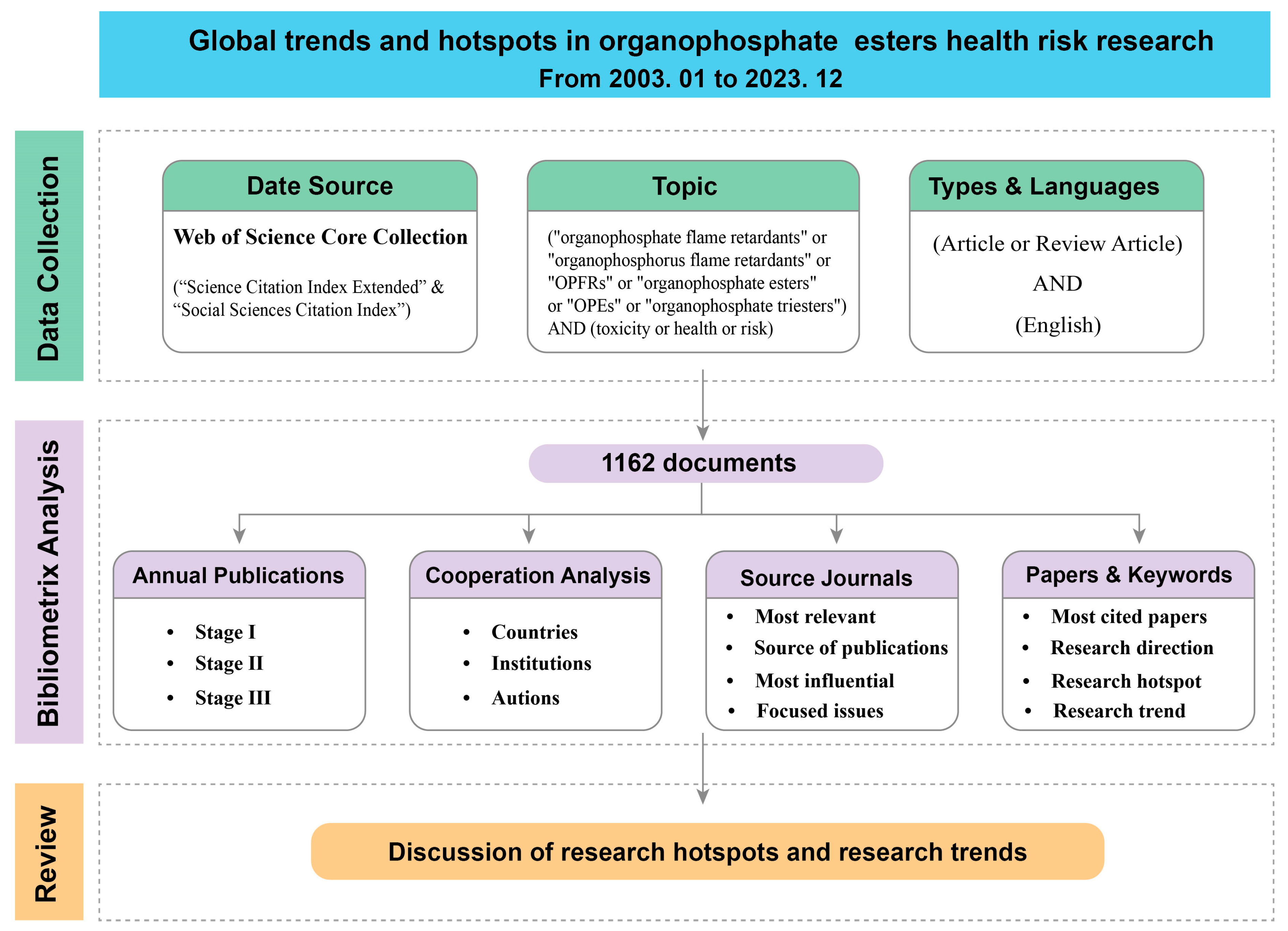

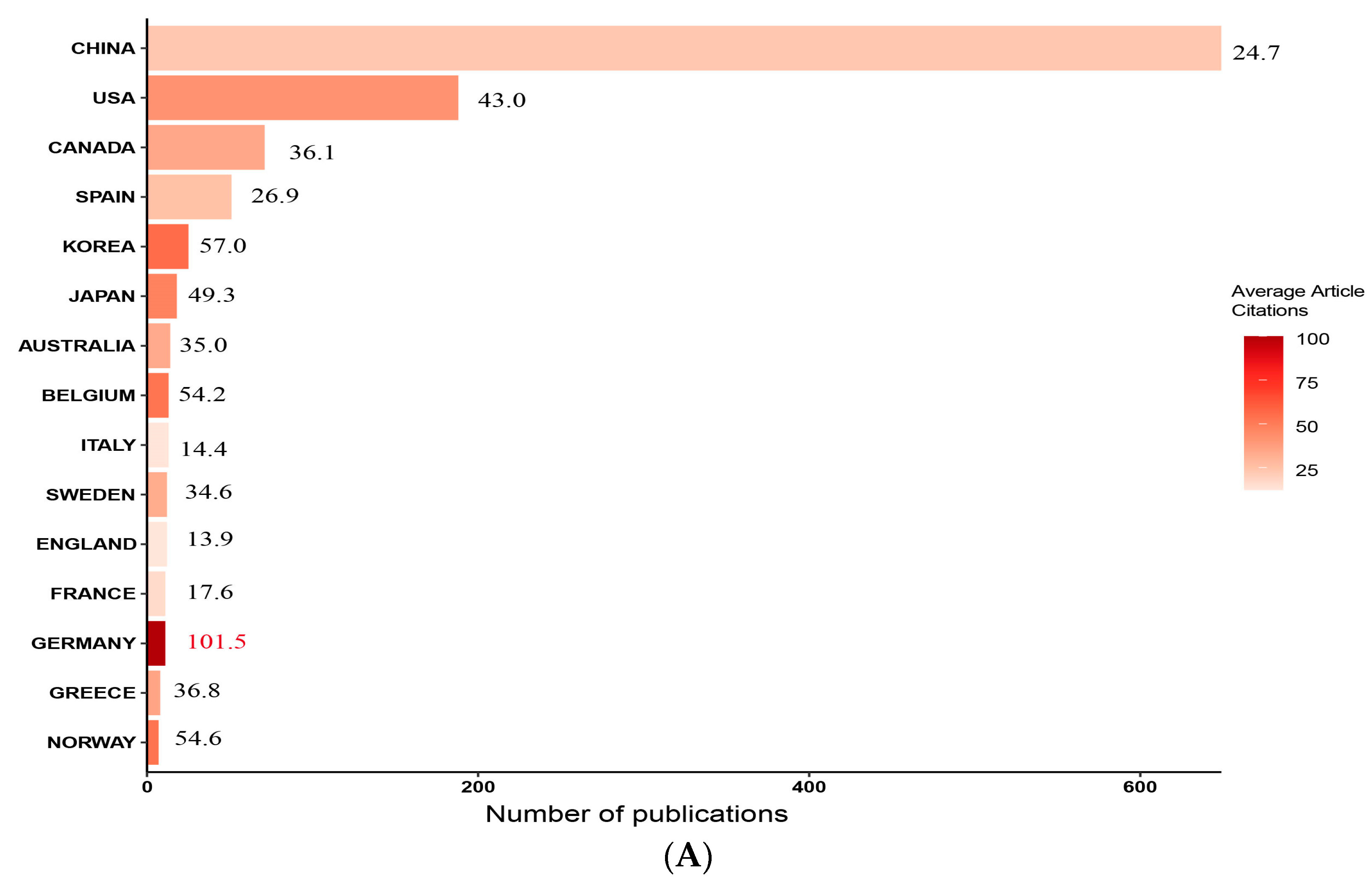
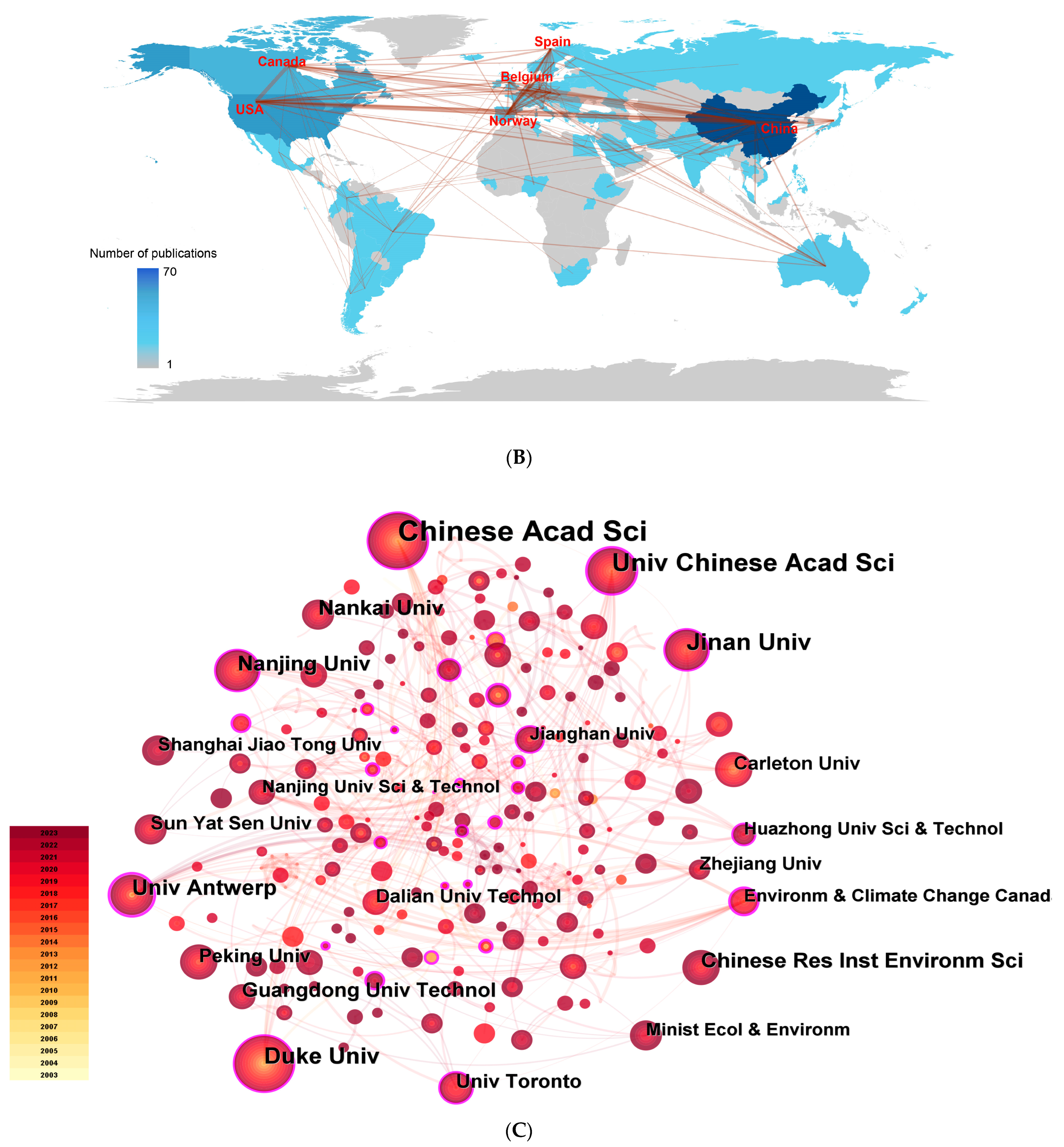
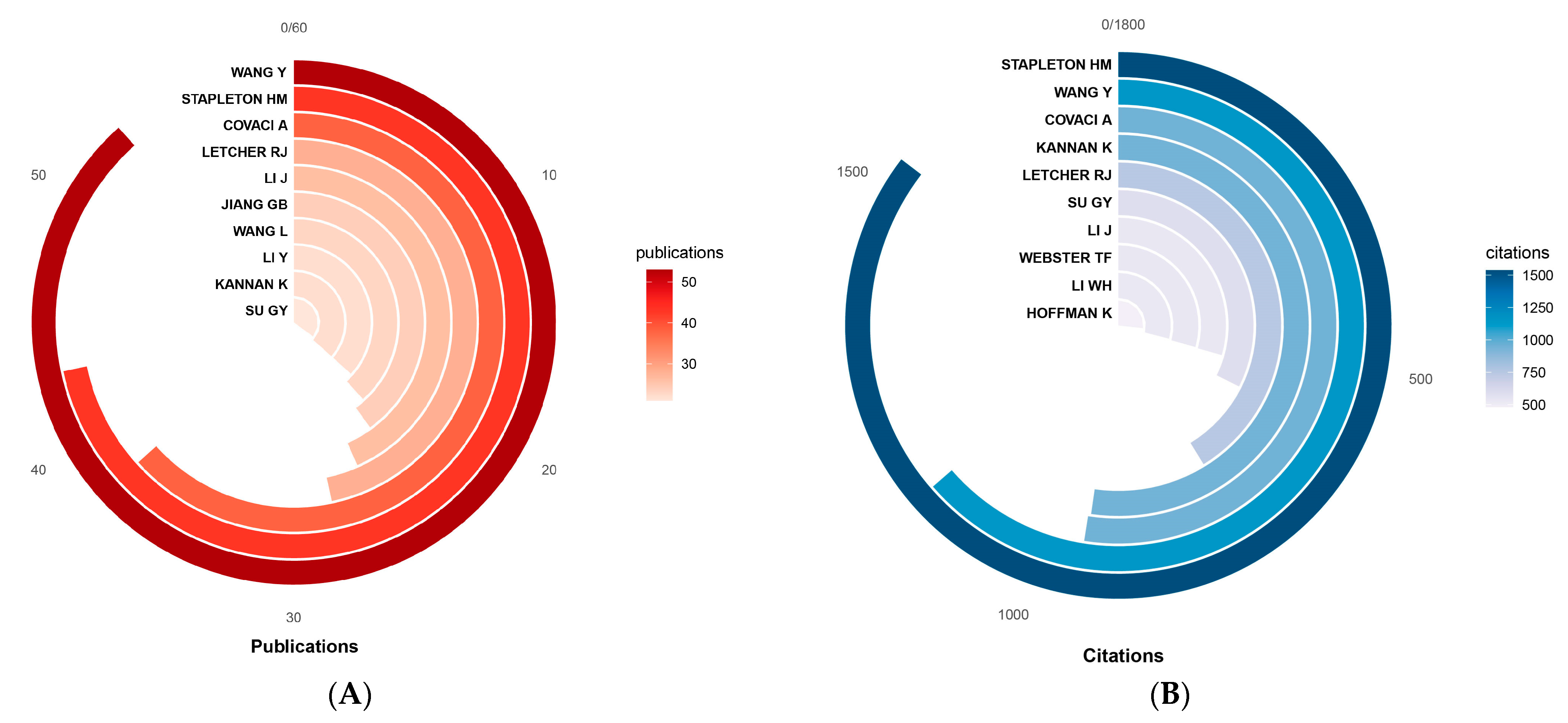

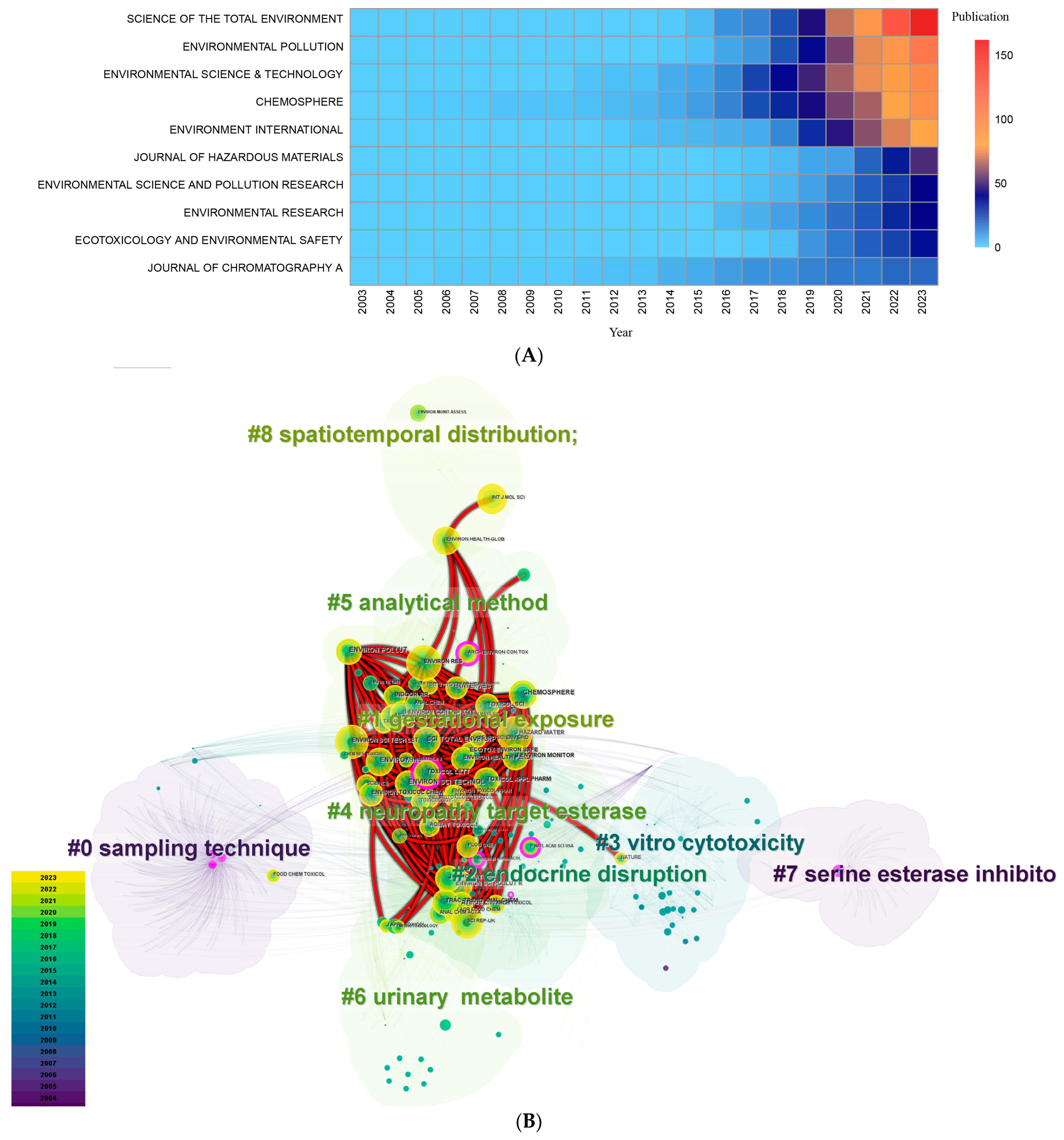
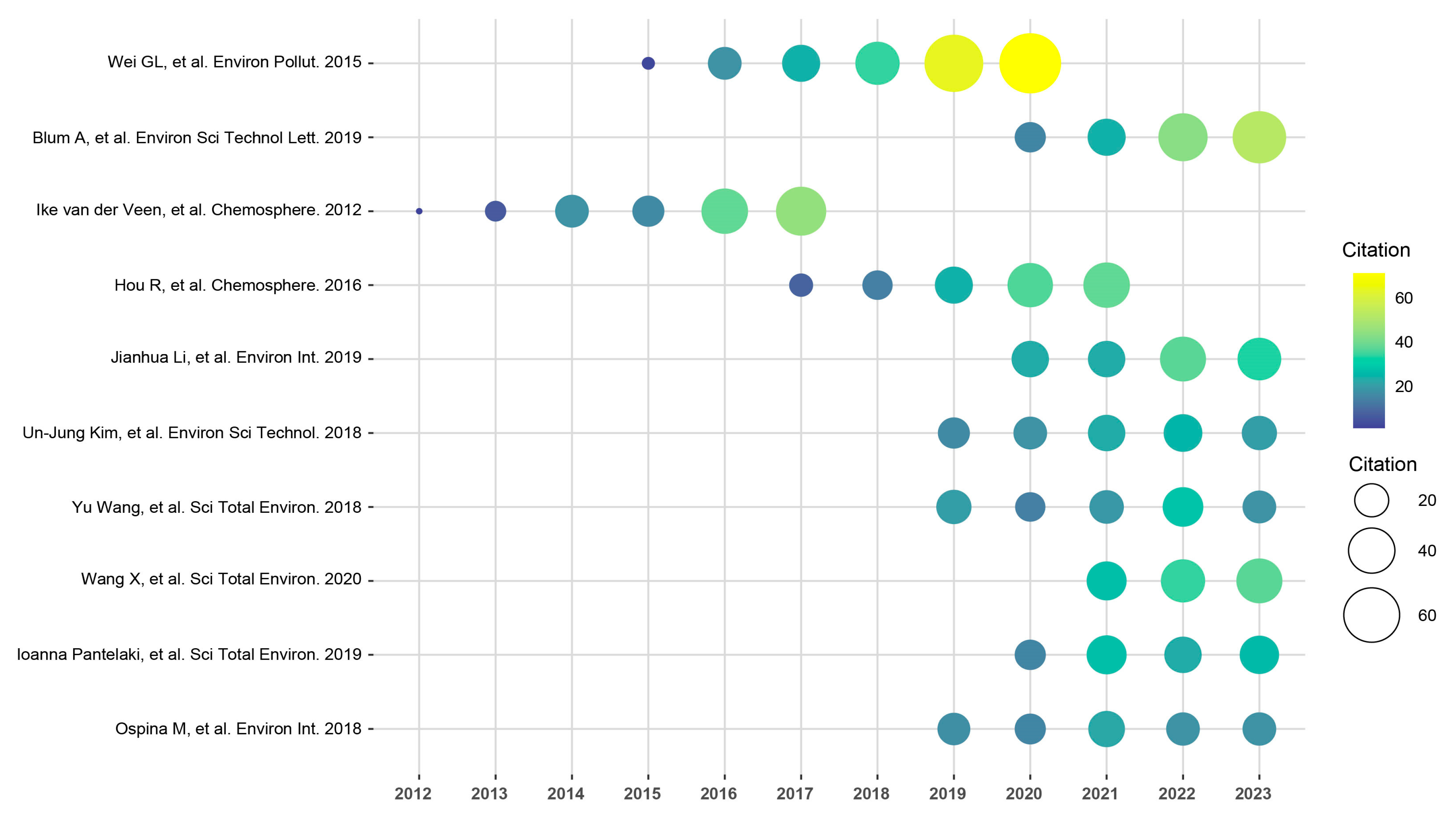
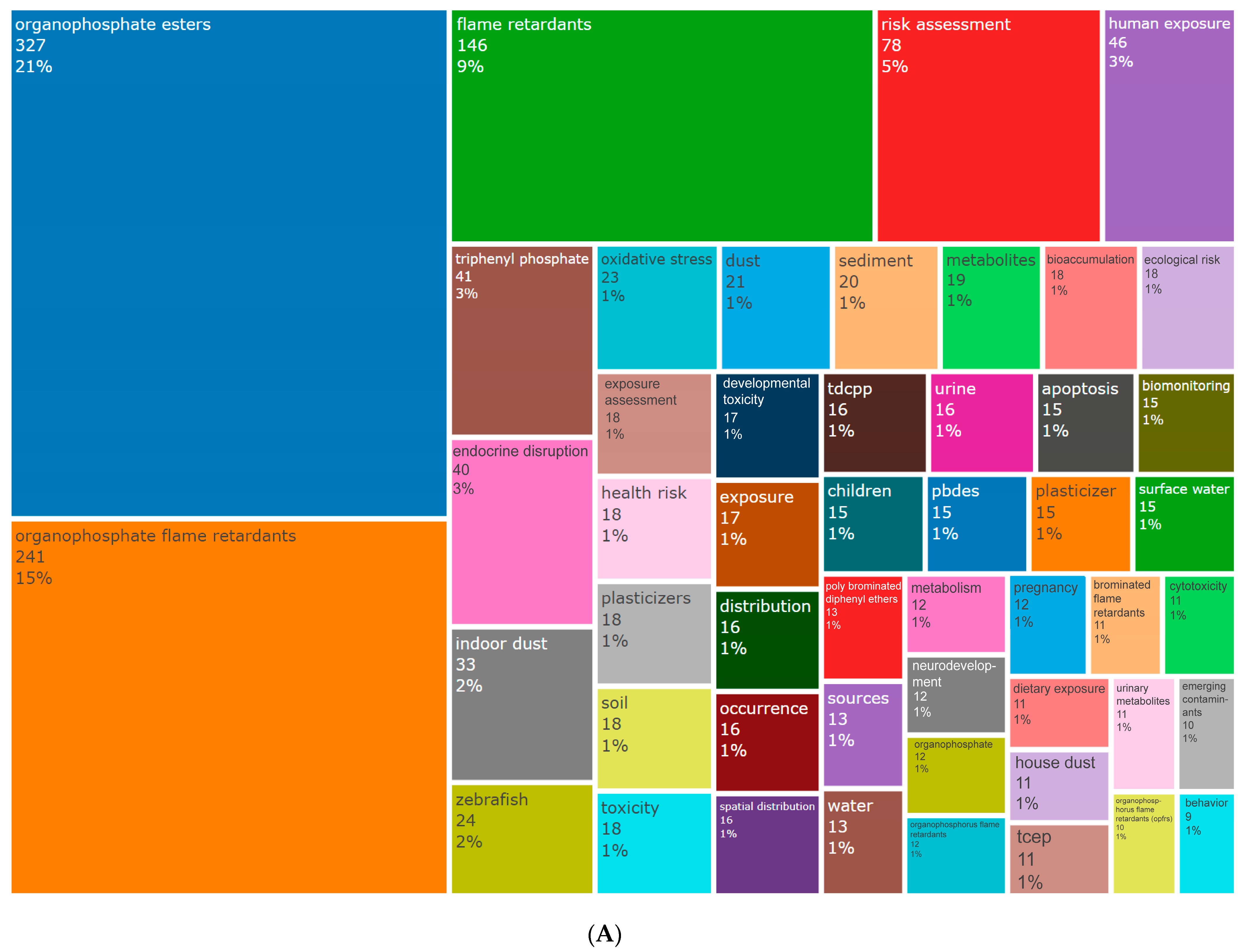
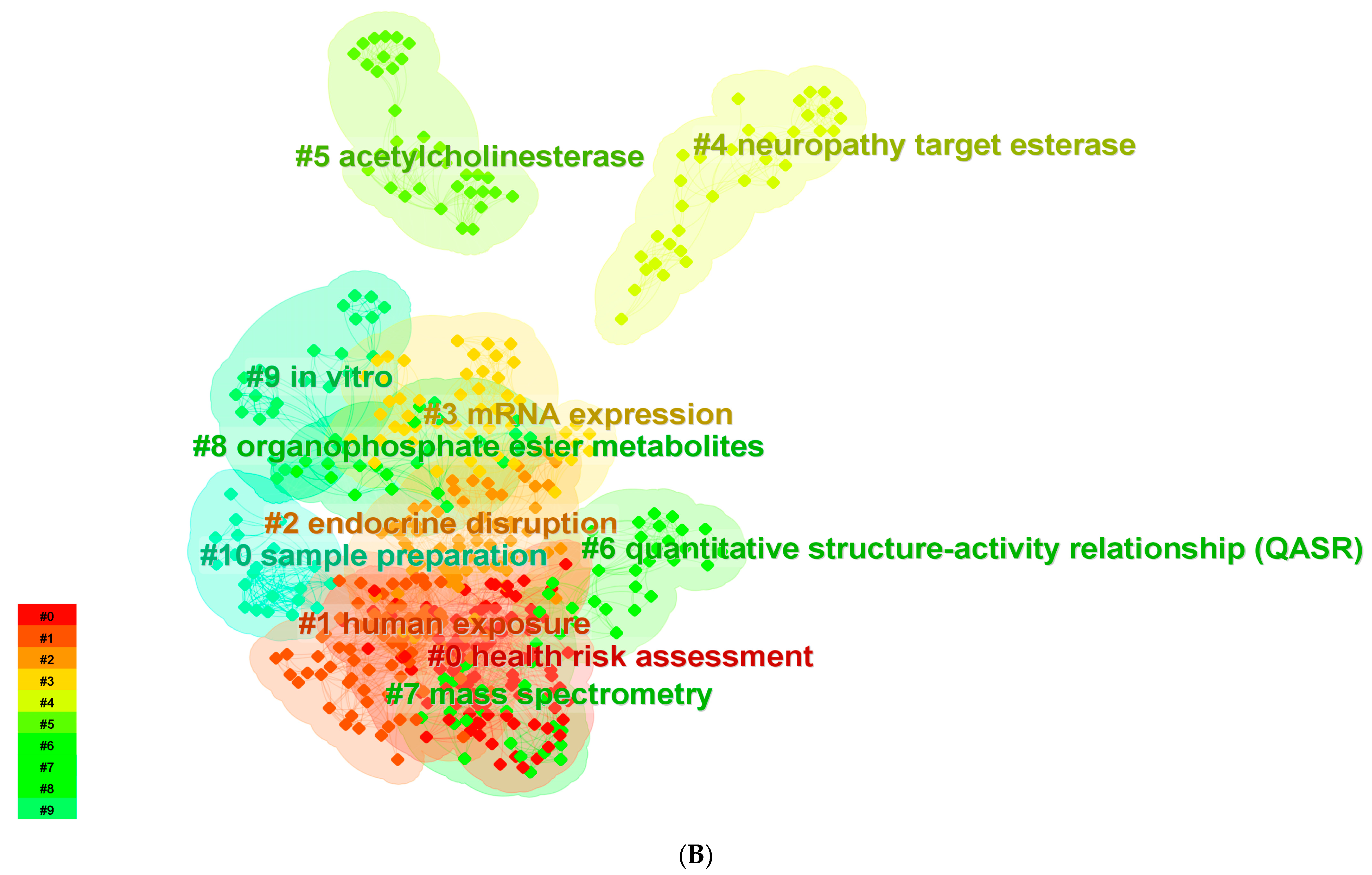
| Keywords | Strength | Begin | End | 2003–2023 * |
|---|---|---|---|---|
| gene | 3.89 | 2004 | 2016 | ▂▃▃▃▃▃▃▃▃▃▃▃▃▃▂▂▂▂▂▂▂ |
| organophosphate ester | 3.80 | 2005 | 2015 | ▂▂▃▃▃▃▃▃▃▃▃▃▃▂▂▂▂▂▂▂▂ |
| gas chromatography | 5.44 | 2007 | 2018 | ▂▂▂▂▃▃▃▃▃▃▃▃▃▃▃▃▂▂▂▂▂ |
| solid-phase extraction | 6.09 | 2008 | 2017 | ▂▂▂▂▂▃▃▃▃▃▃▃▃▃▃▂▂▂▂▂▂ |
| liquid chromatography | 4.74 | 2008 | 2018 | ▂▂▂▂▂▃▃▃▃▃▃▃▃▃▃▃▂▂▂▂▂ |
| indoor environment | 4.37 | 2008 | 2018 | ▂▂▂▂▂▃▃▃▃▃▃▃▃▃▃▃▂▂▂▂▂ |
| identification | 5.45 | 2012 | 2018 | ▂▂▂▂▂▂▂▂▂▃▃▃▃▃▃▃▂▂▂▂▂ |
| rat | 3.24 | 2013 | 2016 | ▂▂▂▂▂▂▂▂▂▂▃▃▃▃▂▂▂▂▂▂▂ |
| thyroid hormone | 2.85 | 2013 | 2017 | ▂▂▂▂▂▂▂▂▂▂▃▃▃▃▃▂▂▂▂▂▂ |
| neurotoxicity | 2.56 | 2014 | 2018 | ▂▂▂▂▂▂▂▂▂▂▂▃▃▃▃▃▂▂▂▂▂ |
| messenger RNA expression | 8.29 | 2014 | 2017 | ▂▂▂▂▂▂▂▂▂▂▂▃▃▃▃▂▂▂▂▂▂ |
| Extraction | 4.48 | 2014 | 2017 | ▂▂▂▂▂▂▂▂▂▂▂▃▃▃▃▂▂▂▂▂▂ |
| zebrafish embryos/larvae | 2.24 | 2014 | 2016 | ▂▂▂▂▂▂▂▂▂▂▂▃▃▃▂▂▂▂▂▂▂ |
| TDCPP | 4.22 | 2014 | 2017 | ▂▂▂▂▂▂▂▂▂▂▂▃▃▃▃▂▂▂▂▂▂ |
| particle | 3.98 | 2014 | 2017 | ▂▂▂▂▂▂▂▂▂▂▂▃▃▃▃▂▂▂▂▂▂ |
| developmental toxicity | 2.13 | 2015 | 2017 | ▂▂▂▂▂▂▂▂▂▂▂▂▃▃▃▂▂▂▂▂▂ |
| variability | 3.74 | 2015 | 2017 | ▂▂▂▂▂▂▂▂▂▂▂▂▃▃▃▂▂▂▂▂▂ |
| persistent organic pollutant | 3.31 | 2015 | 2017 | ▂▂▂▂▂▂▂▂▂▂▂▂▃▃▃▂▂▂▂▂▂ |
| mass spectrometry | 10.31 | 2016 | 2018 | ▂▂▂▂▂▂▂▂▂▂▂▂▂▃▃▃▂▂▂▂▂ |
| house dust | 3.67 | 2016 | 2019 | ▂▂▂▂▂▂▂▂▂▂▂▂▂▃▃▃▃▂▂▂▂ |
| environmental occurrence | 5.48 | 2017 | 2019 | ▂▂▂▂▂▂▂▂▂▂▂▂▂▂▃▃▃▂▂▂▂ |
| human exposure | 4.82 | 2017 | 2019 | ▂▂▂▂▂▂▂▂▂▂▂▂▂▂▃▃▃▂▂▂▂ |
| outdoor air | 3.99 | 2017 | 2019 | ▂▂▂▂▂▂▂▂▂▂▂▂▂▂▃▃▃▂▂▂▂ |
| halogenated flame retardant | 3.56 | 2017 | 2020 | ▂▂▂▂▂▂▂▂▂▂▂▂▂▂▃▃▃▃▂▂▂ |
| sewage treatment plant | 3.36 | 2017 | 2018 | ▂▂▂▂▂▂▂▂▂▂▂▂▂▂▃▃▂▂▂▂▂ |
| indoor dust | 11.35 | 2018 | 2019 | ▂▂▂▂▂▂▂▂▂▂▂▂▂▂▂▃▃▂▂▂▂ |
| settled dust | 7.08 | 2018 | 2020 | ▂▂▂▂▂▂▂▂▂▂▂▂▂▂▂▃▃▃▂▂▂ |
| in vitro metabolism | 5.52 | 2018 | 2021 | ▂▂▂▂▂▂▂▂▂▂▂▂▂▂▂▃▃▃▃▂▂ |
| diphenyl phosphate | 5.35 | 2018 | 2021 | ▂▂▂▂▂▂▂▂▂▂▂▂▂▂▂▃▃▃▃▂▂ |
| urinary metabolite | 3.26 | 2019 | 2021 | ▂▂▂▂▂▂▂▂▂▂▂▂▂▂▂▂▃▃▃▂▂ |
| sediment | 6.16 | 2020 | 2023 | ▂▂▂▂▂▂▂▂▂▂▂▂▂▂▂▂▂▃▃▃▃ |
| foodstuff | 5.47 | 2020 | 2023 | ▂▂▂▂▂▂▂▂▂▂▂▂▂▂▂▂▂▃▃▃▃ |
| dietary exposure | 8.51 | 2021 | 2023 | ▂▂▂▂▂▂▂▂▂▂▂▂▂▂▂▂▂▂▃▃▃ |
| nontarget screening | 6.47 | 2021 | 2023 | ▂▂▂▂▂▂▂▂▂▂▂▂▂▂▂▂▂▂▃▃▃ |
| seasonal variation | 4.86 | 2021 | 2023 | ▂▂▂▂▂▂▂▂▂▂▂▂▂▂▂▂▂▂▃▃▃ |
| in vitro | 4.16 | 2021 | 2023 | ▂▂▂▂▂▂▂▂▂▂▂▂▂▂▂▂▂▂▃▃▃ |
Disclaimer/Publisher’s Note: The statements, opinions and data contained in all publications are solely those of the individual author(s) and contributor(s) and not of MDPI and/or the editor(s). MDPI and/or the editor(s) disclaim responsibility for any injury to people or property resulting from any ideas, methods, instructions or products referred to in the content. |
© 2024 by the authors. Licensee MDPI, Basel, Switzerland. This article is an open access article distributed under the terms and conditions of the Creative Commons Attribution (CC BY) license (https://creativecommons.org/licenses/by/4.0/).
Share and Cite
Du, Z.; Ruan, Y.; Chen, J.; Fang, J.; Xiao, S.; Shi, Y.; Zheng, W. Global Trends and Hotspots in Research on the Health Risks of Organophosphate Flame Retardants: A Bibliometric and Visual Analysis. Toxics 2024, 12, 391. https://doi.org/10.3390/toxics12060391
Du Z, Ruan Y, Chen J, Fang J, Xiao S, Shi Y, Zheng W. Global Trends and Hotspots in Research on the Health Risks of Organophosphate Flame Retardants: A Bibliometric and Visual Analysis. Toxics. 2024; 12(6):391. https://doi.org/10.3390/toxics12060391
Chicago/Turabian StyleDu, Zhiyuan, Yuanyuan Ruan, Jiabin Chen, Jian Fang, Shuo Xiao, Yewen Shi, and Weiwei Zheng. 2024. "Global Trends and Hotspots in Research on the Health Risks of Organophosphate Flame Retardants: A Bibliometric and Visual Analysis" Toxics 12, no. 6: 391. https://doi.org/10.3390/toxics12060391





